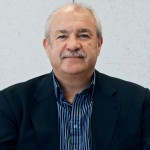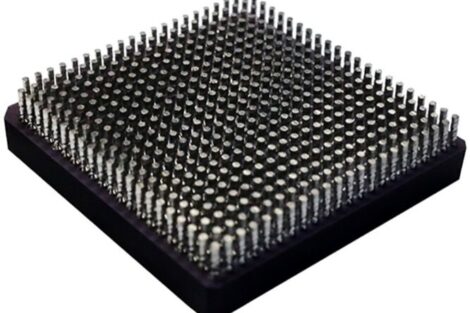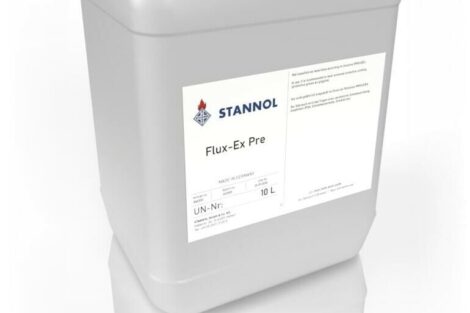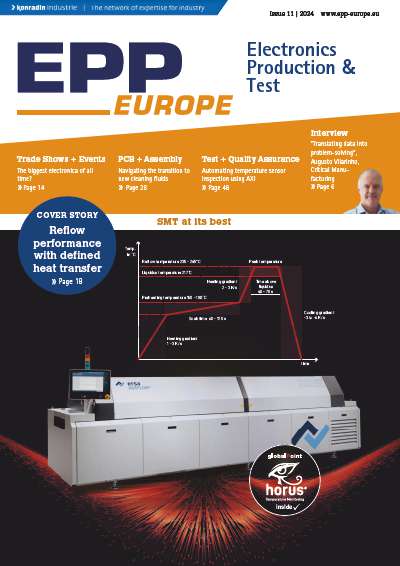Cookson intends to transfer European manufacturing to its sites in Continental and Eastern Europe over the next two years. In this interview with EPP Europe David Crimp, Vice President – Europe, Cookson Electronics Assembly Materials, talks about his plans for the European operation and about future trends and new products. David Crimp was accompanied by Markus Schmidt, the new Regional Sales Director – Central Europe.
Mr. Crimp, what are your plans for the European operation? Will there be many changes?
Yes. The big change will be in our manufacturing facilities. We have a factory in UK where the lease is running out, so we have been able to review our European Manufacturing strategy.
This factory makes three types of products: solder paste, associated chemicals and some water treatment products, which are not for the electronics market. The Alpha solder paste production we shall move to Hungary, a place called Dunaharaszti in the Budapest region. We are in the final stages of building a purpose designed, state-of-the-art solder paste facility there. The project is an exciting one, designed to better serve the market and our major volume customers.
In recent years, the majority of the volume surface mount soldering has moved from Western Europe, particularly the UK, Scotland and Ireland, to Eastern Europe and even beyond to Russia.
By having a solder paste factory in Budapest we feel, we will be very close to our significant volume customers. Our solder paste business remains strong in Germany, but the major growth areas, currently, are Poland, Hungary and Romania and now even the Ukraine.
Solder paste is a product where consistency is vital and that appears to be best achieved by removing as many variables as possible, producing it in larger batches and, if possible, using single facility, so that is the route we have chosen.
The move will make logistics and transportation easier and our investment in cutting edge manufacturing equipment will ultimately gives a better and ever more consistent product to our customers.
As for the Alpha chemical products, we will be moving the production of these to our existing Cookson Electronics facilities in the Netherlands and Langenfeld near Düsseldorf. All of these changes will be complete before the end of next year and paste production in Hungary will be starting early in the New Year.
What makes Eastern Europe so attractive?
There is obviously some labour cost advantages when compared to Western Europe though those differentials are closing fast, but that wasn’t the main driver for us. Hungary was a good place for finding the skilled people that we need to make good solder paste. It has a very good central location, good logistics and we already had a sales office there along with a stencil manufacturing plant. Although that stencil manufacturing facility is a very small operation it provides a sound basis for continued development.
Do the engineers or employees in these new sites get a special training in the UK?
Yes, right now we’ve hired most of the people we need in Hungary and they are actually commuting, spending one or two weeks at a time, in England learning the manufacturing techniques and systems.
I’m very pleased to say the attitude of our English staff has been very good. They are helping to train these people, getting them familiar with making the products in the UK, so that when they move back to Hungary they are fully trained and ready. In December we will start the transition, moving the manufacture of solder paste, product by product from the UK to Hungary.
What happens to the workers or employees at the UK facility?
They sadly will be made redundant and will lose their jobs. We’ve undertaken the usual consultations and have given them all the time and assistance we can to find alternative employment. We have been able to offer some alternative employment at our Woking plant and others have been able to take early retirement but it’s never-the-less a sad, if inevitable situation for some.
Large industrial players have cut back on production. What impact does this have on your company?
Right now, we have not made any cut backs in production. The business for us has been quite strong through October. We have experienced an increase in demand for solder paste from mobile phone manufacturers and their subcontractors in Eastern Europe which is keeping us very busy.
I do feel however, that we will not be unaffected by the current World slowdown but so far we are not experiencing it just yet, although after Christmas the situation could well change.
How can this downturn be overcome?
We are really a volume business in a technology led industry. That is to say, even though the financial situation of some of our customers may be poor, as long as people are still developing, making and buying new mobile phones, TV screens, computers etc. there will always be a demand for our products.
The volume may go down but the long term prospects remain good. The appetite for all of these “luxury” goods is still strong in the east of Europe and therefore, as long as people are buying these things, we will still have business. In a nutshell we expect volumes to reduce but stabilize at a reasonable and sustainable level for us. Our manufacturing is such that we can adjust the production volume by changing the number and pattern of shifts we work, so we don’t, at this stage, have to lay off operatives.
What technical challenges or issues are driving your product development?
Well, I guess, overwhelmingly the driver for this has been the move to lead-free. The first challenge was the metallurgical one, finding other materials that have similar properties to tin-lead. We have seen the development or evolution of tin-silver-copper products, the so-called SAC alloys which are now well established.
The second challenge has been the escalation in the raw material prices, notably tin and silver. So this has led us in turn to look for some alternative alloys which have reduced silver content. About a year ago Alpha launched a range of lower tin SACX products, in bar form as well as for solder paste and cored wire.
Changes in the flux chemistry have been necessary to accommodate the higher melt temperatures of these tin-silver-copper alloys.
This has led to a naturally evolved series of new products, which has helped to keep our business strong and has helped us leverage Cookson’s or Alpha’s technology and position. Having a big R&D facility worldwide, we have been able to generate these many new formulae in a timely manner.
The continued reduction in stencil aperture size is another driver, which has been here since I first came into the business over 20 years. We are producing solder pastes with ever-smaller particle size powders to accommodate this.
A further driver for these metal products has been issues concerning the thermal cycling and we’ve undertaken a lot of work in this area. One product development that we’ve undertaken, this time as part of a consortium, is InnoLot an alloy produced for the automotive market.
Can you tell us a little bit about it?
Markus Schmidt takes over: InnoLot is a new development, a lead free alloy that was started as a BMBF project, sponsored by the European Union. Partners in developing this alloy are Siemens, Bosch and some of our competitors. It’s a patented alloy, mainly developed to overcome vibration and thermal cycling concerns that exist with standard SAC lead-free alloys.
The automotive industry wishes to site control modules where each operation is carried out… engine control modules on the engine and ABS modules on the brakes themselves. These places are invariably where the heat and vibration conditions are at there worst and InnoLot performs admirably in such locations. However, this is not only an alloy for the automotive industry. It can also be used in other areas where you have requirements for higher temperatures up to 150 °C operating temperature and/or vibration.
We have already had enquiries from non-automotive customers about potential applications where heat and vibration are recognised problem. An example of this is in non-automotive LED lighting technology. These don’t generally suffer from vibration but they do suffer higher operating temperatures. InnoLot is a new, patented alloy designed specifically for use under these conditions and the industry is looking at it seriously.
Have you already launched this alloy?
Schmidt: It is an already launched product. In automotive electronics it is a little bit difficult because carmakers have a very long development cycle due to reliability and safety issues. However one of the major automotive manufacturers is already using the material in the production of new ABS modules.
What else is new?
Back to David Crimp: I think the other area of developments is also in our chemistry and that is the drive towards low or zero halogens and halides in product formulation. Some halogens are reported to be potentially harmful when incinerated but there are also reliability issues to be considered. This demand is coming from the US and also from the Far East and upper limits have been suggested by International Electrochemical Commission and the IPC. Within the last few months we have launched a range of products that are zero halogen… not low halogen but zero halogen. We are finding a lot of interest in these zero halogen Japanese and Korean to Europe and the Americas.
Are they made for automotive?
Crimp: Not yet, but I believe the automotive industry will be interested in this in the near future. We are already seeing interest from customers using flip chip or chip on board technology although this appears to be driven by Japanese standards. So we’ve covered the metal and the chemical products as a kind of an overview. We could talk about this for ages, but I think they are the main points to get across.
Schmidt: Let me please say something to the economic downturn in the industry, for example in the automotive industry. This is only a guess from my side but the development departments probably now have time to source and evaluate the new materials in order to be ready for the switch to lead-free in 2010/2011. A little slack in the system will enable them to actively seek new solutions and get time to test material on lines instead of being blocked by 100 or 120 % volume production.
What about solar solutions? Are you active in photovoltaic?
Crimp: Yes, that’s an interesting area. Maybe we’ve been a little late getting into it, but we are into it now with amazing investments and are now launching a new product called “PV-Ready Ribbon”. Solar tabbing ribbon is the term used for the solder coated copper strip used to join the photovoltaic cells during solar module manufacture. These ribbons are generally applied using a liquid flux which is messy to apply and can be the cause of major problems. We at Alpha have developed and patented a flux coated ribbon that overcomes these problems.
This is an exciting development for us in the Alpha European operation as the major markets are all European. Germany is the largest producer of these solar modules right now, then Spain and then Italy – so it is an area where Europe, for once, leads the world.
We are hoping that will help grow our business overall. The electronics assembly market if not flat, is growing only slowly in Europe whereas the Photovoltaic market is growing at something like 20 to 30 % a year.
Can you give us any hints as what’s new for 2009?
I would like to talk first on the commercial side about the other phenomenon that’s happened in the last couple of years in relation to solder –the escalation of tin prices. We’ve seen the price of tin, a fundamental material that all solder manufacturers use, go from under 10,000 $ a tonne to over 25,000 $ a tonne.
The tin market has come down now, but because the amount of tin used in the market is controlled closely by the suppliers, the price will probably stabilise at the level it is now… between 15,000 to 20,000 $ a tonne.
What we try to do for our customers both on the metal side and the solder paste side is to reflect the current price of tin in a surcharge. It’s a way for us fairly and openly to pass on the fluctuations fairly as they occur.
Silver is also a costly problem. The classic lead-free alloys contain 3.5 and 4.5 % silver a precious commodity that currently costs around 350,000 $ per tonne but has been more than twice that earlier in the year. We are working to produce materials have less than 1 % and in some cases less than 0.5 % silver… alloys that offer similar performance characteristics to high silver materials without the prohibitive costs… So expect the launch of new alloys along these lines.
As far as other products go, I think I’ve touched on them already: the halogen free materials and the PV-Ready Ribbon, those will be our main new products for next year.
We’ve found a lot of interest and seen growth of our pre-forms business. Pre-forms are often a way to add an extra volume of solder to a joint when it’s not easy, or even possible to change the solder paste deposit volume through changing the stencil design. Pre-forms have proved the solution to many ‘print through hole’ applications and we now supply them in tape and reel format for automatic placement along with the components.
Pre-forms are manufactured in our Naarden facility near Amsterdam where we’ve recently invested in the tape and reel packaging equipment. We have every confidence that this is yet another in the long line of Alpha assembly solutions that has significant commercial potential. (jau)
EPP Europe 513
Share:













